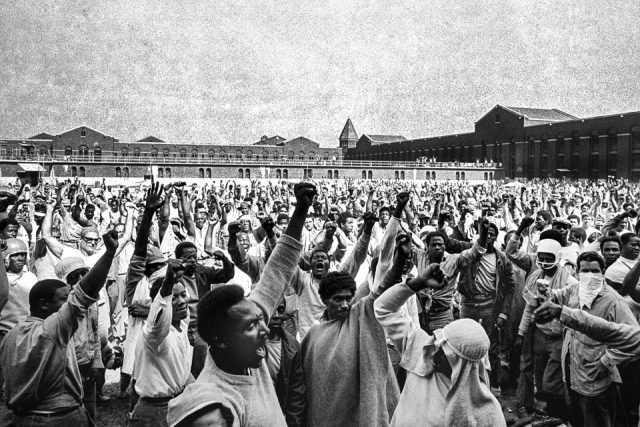
This Sept. 10, 1971 file photo shows prisoners of Attica State Prison as they raise their hands in clenched fist salutes to voice their demands during a negotiating session with New York’s prison Commissioner Russell Oswald. NY Gov. Nelson Rockefeller later ordered troops to fire into the yard, killing 33 prisoners and 10 guard hostages. AP File Photo
VOD is publishing excerpts here detailing prisoner uprisings in Michigan’s own Kinross Correctional Facility, as well as Alabama, Texas, and Florida. The uprisings are a response to a call for a national prisoners’ strike on the 45th anniversary of the Attica prison uprising Sept. 9, 1971.
PRISONERS AT KINROSS CORRECTIONAL FACILITY STRIKE, PROTEST TO REMEMBER ATTICA REBELLION
By Mallory Anderson |
September 11, 2016, UPDATE 11:40 pm
KINCHELOE, Mich. (WLUC) – UPDATE: 11:40 p.m. 9/10/2016
 (VOD note: Kinross is one of the state’s worst prisons. VOD has received complaints from family members of prisoners there for some time, citing mistreatment of their loved ones, including the use of racist remarks by white guards such as the “N” word and “boy,” and false allegations made by white prisoners against Black prisoners which were used by prison officials at Kinross to the detriment of the Black prisoners. There have also been repeated stabbings and fights there due to the misclassification of dangerous prisoners, who should have been at Level 5, which Kinross does not accommodate.)
(VOD note: Kinross is one of the state’s worst prisons. VOD has received complaints from family members of prisoners there for some time, citing mistreatment of their loved ones, including the use of racist remarks by white guards such as the “N” word and “boy,” and false allegations made by white prisoners against Black prisoners which were used by prison officials at Kinross to the detriment of the Black prisoners. There have also been repeated stabbings and fights there due to the misclassification of dangerous prisoners, who should have been at Level 5, which Kinross does not accommodate.)
The protest of hundreds of prisoners at Kinross Correctional Facility Saturday morning began peacefully but ended with some inmates damaging their housing units.
According to Chris Gautz, the Michigan Department of Corrections Public Information Officer, around 400 prisoners marched peacefully as a form of protest outside the prisoner housing units of Kinross Correctional Facility Saturday morning from 8:50 a.m. to 12:30 p.m.
The protest was held to coincide with the 45th annual anniversary of the Attica Correctional Facility riots in upstate New York. Though KCF was the only prison in Michigan that experienced any form of protest this weekend, several other states across the U.S. encountered prisoner protests as well.
The warden and facility staff were able to convince the inmates to return to their housing units after speaking with the leaders of the march.
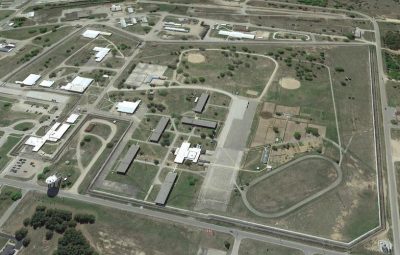
Aerial view of Kinross Correctional Facility/MDOC
As the department began its efforts to remove prisoners involved in instigating the protest, some inmates caused damage to their housing units. According to the Associated Press, some inmates smashed sinks, started a small fire and broke at least one window. 150 prisoners were then transported to other facilities. Gautz did not specify which facilities they were transported to.
There were no injuries to any prisoners or staff during the protest or after.
Kinross Correctional Facility in Kincheloe houses around 1,200 level I and level II prisoners. It is in Chippewa County near Sault Ste. Marie.
HUNDREDS OF FLORIDA INMATES RIOT TO PROTEST PRISON CONDITIONS
by thegrio | September 9, 2016 at 7:07 PM
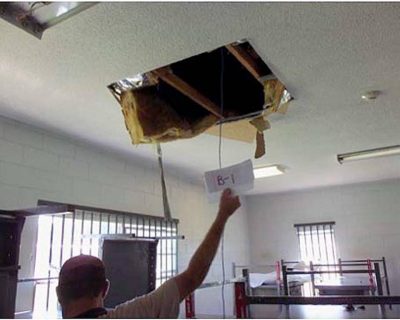
Damage at Holmes Correctional Facility in Florida.
On Wednesday, a riot at Florida’s Holmes Correctional Institution left almost every single dorm damaged and saw more than 400 inmates involved in a revolt that lasted until early Thursday morning.
Officers were called in from five different prisons as well as RRTs (Rapid Response Teams). While officers were armed, no shots were fired. According to the Florida Department of Corrections there was one inmate injury and no staff injuries.
According to The Miami Herald, the riot came before a nationwide strike that is planned for Friday to protest what inmates say is violent and barbaric treatment in prisons.
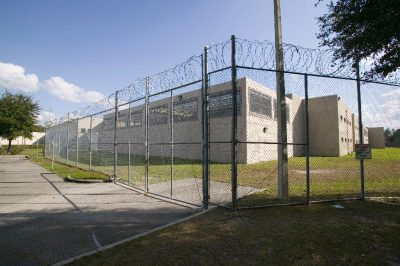
Holmes Correctional Institution in Florida
For over a year, Florida’s prison system, which is the third largest system in the country, has been understaffed, which has resulted in several inmate takeovers in recent weeks as inmates express frustration about their forced confinement.
Apparently, the system is so understaffed that inmates are only allowed out when it is time to eat, because there are not enough staff members to guard them for recreation periods.
Phillip A. Ruiz, an organizer for the Incarcerated Workers Organizing Committee, told The Herald that the national protests would be nonviolent.
“They are participating in work stoppages, hunger strikes and sit-ins in protest of long-term isolation, inadequate healthcare, overcrowding, violent attacks and slave labor,” he explained.
Today happens to be the 45th anniversary of the Attica Prison riot in New York, which left dozens of employees and inmates dead as prisoners protested living conditions. Ruiz says prison conditions haven’t changed much since then.
VOD: Read The Attica Prisoners’ Demands at http://voiceofdetroit.net/wp-content/uploads/Attica-Prisoners-Demands.pdf
 IS ANOTHER ATTICA ON THE HORIZON?
IS ANOTHER ATTICA ON THE HORIZON?
http://www.theatlantic.com/politics/archive/2016/09/is-another-attica-on-the-horizon/499397/
Friday is the 45th anniversary of the 1971 Attica Prison uprising. Twenty-nine prisoners and ten hostages were killed when police took back control of the facility after inmates rioted, demanding better conditions.
To mark the occasion in 2016, prisoners in Alabama and Texas called on fellow inmates from 24 states to join a general strike to protest living and working conditions. Two days ago, a Florida prison was one of the first to have its population join the movement when 400 inmates at Holmes Correctional “caused damage to nearly every dorm during an uprising that lasted into the early morning,” according to the Miami Herald.
 Historian Heather Ann Thompson argues that there’s a direct line between the deadly 1971 Attica protests and the current call for action. For her latest book, Blood in the Water: The Attica Prison Uprising of 1971 and Its Legacy, she spent over a decade unlocking the secrets and sifting through the misinformation about the infamous prison revolt that still shapes our society’s perception of and relationship to incarceration. An edited and abridged version of our conversation follows.
Historian Heather Ann Thompson argues that there’s a direct line between the deadly 1971 Attica protests and the current call for action. For her latest book, Blood in the Water: The Attica Prison Uprising of 1971 and Its Legacy, she spent over a decade unlocking the secrets and sifting through the misinformation about the infamous prison revolt that still shapes our society’s perception of and relationship to incarceration. An edited and abridged version of our conversation follows.
Lantigua-Williams: What was the root cause of the Attica uprising in 1971?
Thompson: The root causes of the Attica rebellion were, as they are with the rebellions today, abysmal conditions in our nation’s correctional facilities. In 1971, all the Attica prisoners first tried to remedy those terrible conditions by working through the system, by writing their state senators and petitioning the commissioner of corrections, even by having a work stoppage, sitting down in the metal shop at Attica to ask for a living wage. They actually needed money to survive in Attica since the state provided so little food, so few sanitary supplies, and such poor medical care. The rebellion happened because their needs weren’t addressed and, frankly, it happened for the very simple reason that, even as men and women serve time behind bars, their sentence does not include deprivation—deprivation of food or deprivation of medical care. Yet, that was exactly what those sentences were for the men in Attica.
Lantigua-Williams: Do you see similar circumstances today?

Author Heather Ann Thompson
Thompson: Yes, absolutely. One of the tragic outcomes of the Attica uprising was that the state of New York stood in front of the world and told a narrative of that uprising that was rife with lies. As a result of those lies told after Attica, the nation really sours on this idea that prisoners deserve good treatment behind bars. The long-term upshot of that was that this nation, every decade after Attica, becomes more and more punitive. Today, we have a very ironic situation: on the one hand, because of lies told after Attica we have horrendous prison conditions; also because of Attica, we have prisoners who believe that if they stand together and if they speak up they might still find some measure of justice in this system, that they will perhaps humanize the conditions where they’re locked up. In that sense, Attica has everything to do with why we are here again today.
Lantigua-Williams: What do you know of conditions or policies in Alabama and Texas that might make those states ripe for this type of protest coming from within these institutions?
Thompson: Texas is one of the largest and most brutal prison systems in the nation, rivaled by other states such as Louisiana, but not just Southern states. Northern states and Western states have the exact same brutal conditions. What is very notable about the South is that there has been a wholesale abandonment of the idea that prisoners deserve any good treatment behind bars.
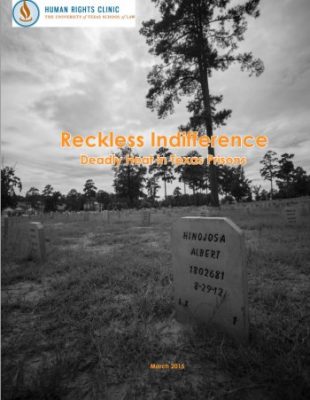
Report by University of Texas School of Law Human Rights Clinic 2015
In Texas, for example, prisoners are literally locked in cages longer and longer than they ever have been, with no time out of the cell. It’s sweltering, of course, because it’s Texas. It is hundreds of degrees in these cement cages. They’re serving horrendous time in solitary. They’re again being mistreated with lack of food, again suffering lack of sufficient medical care. In those states in particular, it is the physical confinement of these people that is so brutal, but also these states’ utter abandonment of their duty to treat them as people, that has concentrated these protests in these areas.
“It is the prisoners who are refusing to let these conditions just continue so barbarically without speaking up.” . . . .
Lantigua-Williams: What do you think is a realistic set of outcomes for those protesting? Do you anticipate that there might be some serious retaliation? How do you think it might be handled?
Thompson: I am deeply fearful of what the outcome of this is going to be. There is no question that it’s profoundly important to hear from people behind bars, what they need, and to see people speaking out. I am fearful because the retribution is sure to be brutal. Right now as we speak, knowing that 400 prisoners in Florida engaged in a major protest last night, I worry very, very much at this moment about what is happening in that prison. Prisons are state institutions that we pay for. The fact that I can’t tell you what is happening right now in that correctional facility to those men is horrifying.
Lantigua-Williams: If you were on a presidential advisory panel, what would you advise the next president to do first to address the prison system?
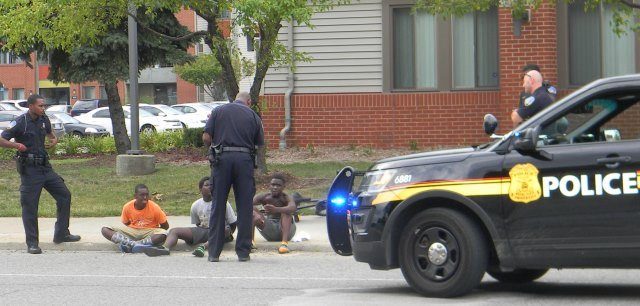
Several police cars converged on three Black children in Detroit near Wayne State University’s campus Aug. 14, 2016, handcuffing them and questioning them for an extended period. This photographer called out: “Why are you harassing these children?” and brought attention to the incident by speaking with a nearby coach handling basketball practice at a church. He said such stops are frequent. The children were eventually released. Photo by Diane Bukowski
Thompson: We must begin with a complete overhaul of the criminal justice system—from root to branch. Beginning with excessive policing of social ills. Dealing with social ills, such as drug addiction or poverty, through the criminal justice system or through policing rather than the welfare or education systems needs reforms. Those reforms need to be at every one of the next levels. We need to have better public defenders. We need to have an overhaul of our laws that hold Americans behind bars longer than any other country.
In the institutions, we need to make sure that they are run humanely if they’re going to exist because every one of those people is a returning citizen. When a nation treats its most vulnerable citizens—those over whom it holds the most power—so abusively and like animals, it cannot expect whole people to come out of the other end. Society needs whole people if it does indeed care about public safety.
This article is part of our Next America: Criminal Justice project, which is supported by a grant from the John D. and Catherine T. MacArthur Foundation.
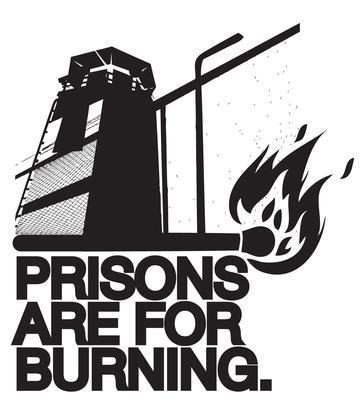 PRISONS ARE FOR BURNING
PRISONS ARE FOR BURNING
by Neal Shirley
Prisoners Call for a National Strike on the Anniversary of Attica
In Alabama and Texas, prisoners have enacted multiple strikes and uprisings over the last few weeks. Now they are calling for a national prison strike on the anniversary of the Attica Prison Riot.
On the night of Friday, March 11th, hundreds of prisoners took over the general population portion of Holman prison in Atmore, Alabama. Viewpoints from the prisoners varied: One described conditions of overcrowding, sending out pictures to accompany the description. Another prisoner said, “It has nothing to do with overcrowding, but with the practice of locking folks up for profit, control and subjugation.”
As that prisoner relayed via social media, “Things here are tense but festive. The CO and warden was stabbed… Fires were set, people got control of two cubicles, bust windows. The riot team came, shot gas, locked down, searched the dorms. Five have been shipped and two put in lockup.” Another prisoner stated simply, “We’re tired of this shit, there’s only one way to deal with it: tear the prison down.”
Though authorities regained control the following day, a second riot took place at Holman Prison early the following Monday morning involving up to 70 inmates. That morning prisoners built barricades and reportedly broke into other areas of the facility. Holman Prison has been a hotbed of organized prisoner activity, with the Free Alabama Movement operating out of the facility as well as anarchist prisoner-author Michael Kimble.
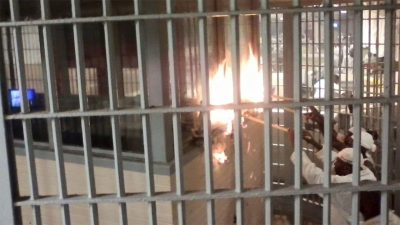
Uprising at Holman Prison in Alabama, April, 2016
On the morning of April 4th “rolling strikes” began in multiple Texas prisons, with one unit already being put on lockdown by their administration at 9:30 am. Inspired by a growing wave of prison strikes in Alabama, Georgia, Ohio, Illinois, and California, these prisoners are part of the IWW’s Incarcerated Workers Organizing Committee (IWOC), the first widespread effort for union recognition among prisoners in decades, with over 750 members in prisons across the country. According to a statement on the IWOC website, the strikes were not officially reported as such, but were concealed as administrative lockdowns – a de-escalation tactic commonly used by prisons and their wardens. Prison administrations had been aware of and worried about the strike. Tellingly, one administration had asked prisoners weeks in advance “to write instructions on how to run the washing machines and industry equipment so that an alternative workforce [could] take over the functioning of the prison.”
But it appears this is only the beginning. Prisoners in these states and many others have coordinated and released a call for a national prison strike on September 9th, 2016, the 45-year anniversary of the Attica Rebellion.
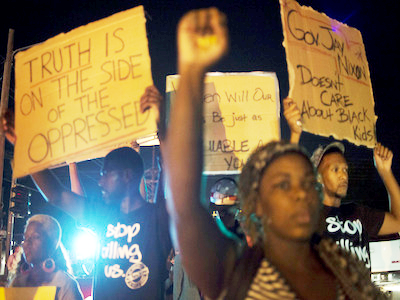
One of dozens of protests in Ferguson and across the U.S. after the police execution of 18-year-old Michael Brown Aug. 9, 2014.
In their call, the prisoners declare, “On September 9th of 1971 prisoners took over and shut down Attica, New York State’s most notorious prison. On September 9th of 2016, we will begin an action to shut down prisons all across this country. We will not only demand the end to prison slavery, we will end it ourselves by ceasing to be slaves.”
They continue, “To achieve this goal, we need support from people on the outside. A prison is an easy-lockdown environment, a place of control and confinement where repression is built into every stone wall and chain link, every gesture and routine. When we stand up to these authorities, they come down on us, and the only protection we have is solidarity from the outside … When we stand up and refuse on September 9th, 2016, we need to know our friends, families and allies on the outside will have our backs. This spring and summer will be seasons of organizing, of spreading the word, building the networks of solidarity and showing that we’re serious and what we’re capable of.”
The connection between fighting back against the police and the struggle against prison is fairly obvious. As the prisoners who put out this call note, “Mass incarceration, whether in private or state-run facilities, is a scheme where slave catchers patrol our neighborhoods and monitor our lives. It requires mass criminalization. Our tribulations on the inside are a tool used to control our families and communities on the outside. Certain Americans live every day under not only the threat of extra-judicial execution – as protests surrounding the deaths of Mike Brown, Tamir Rice, Sandra Bland and so many others have drawn long overdue attention to – but also under the threat of capture, of being thrown into these plantations, shackled and forced to work.”
Up until now, the fierce resistance going on behind bars has received nothing like the attention or solidarity it is owed in comparison with the riots and protests in cities like Ferguson, Baltimore, and beyond. In September 2016, that will change.
https://iwoc.noblogs.org/ (Incarcerated Workers Organizing Committee)
http://www.theatlantic.com/politics/archive/2016/07/7000-deaths-in-custody-texas/493325/
Some of more recent VOD stories related to prisoners’ struggles:
http://voiceofdetroit.net/2012/07/17/tortured-georgia-prisoners-face-death-in-33-day-hunger-strike/
http://voiceofdetroit.net/2012/02/29/time-for-voting-rights-for-michigan-prisoners/
http://voiceofdetroit.net/2011/10/11/12000-california-prisoners-resume-hunger-strike/
http://voiceofdetroit.net/2011/09/26/mdoc-prisoners-mobilize-to-fight-costly-phone-contract/
#RememberATTICA, #StopMassIncarceration, #SupportKinrossprisoners, #SupportHolmesPrisoners, #SupportHolmanPrisoners, #TearDowntheWalls, #RiseUPvsPoliceStatePrisonNation, #Beatbackthebullies





9/12/16
Attn: VOD Editor
While I no longer reside in the Great Lakes area, I have fond memories of my many trips to Detroit for entertainment, sporting events, visiting, etc. I occasionally read your blog to be aware of events in my former home area. Your articles have contained many comments regarding the “School to Prison Pipeline” social trap that is prevalent today. I urge you to read the “Seattle Times”, 9/11/16, article entitled, “Trouble Erupts after Highline Limits School Suspensions” by the Seattle Times Educational reporter, Claudia Rowe (206) 464 – 256 It illustrates both the positive, and negative, aspects of a limited non – suspension policy that was instituted by the Highline Schoold District Superintendent Susan Enfield, approximately 3 years ago. The Highline School system is located in an economically distressed area, of Seattle Washington, and is attended by many disadvantaged students.
I hope that this will be of interest to you.
Don P